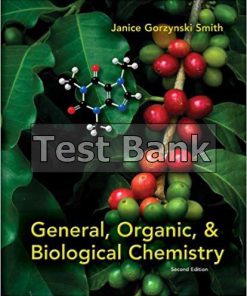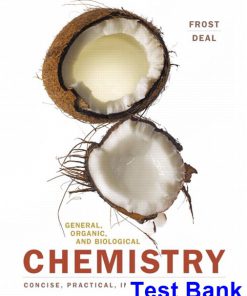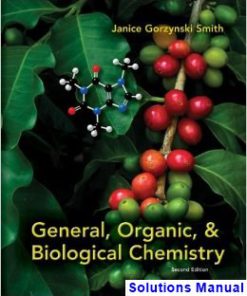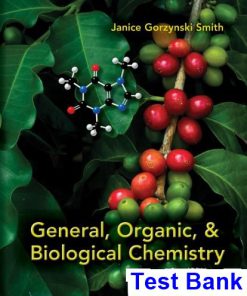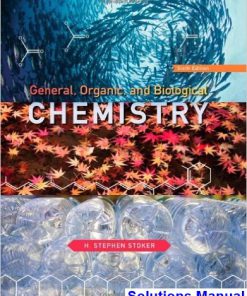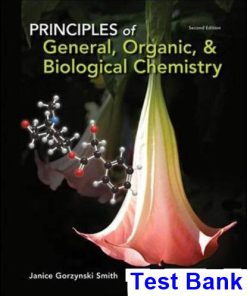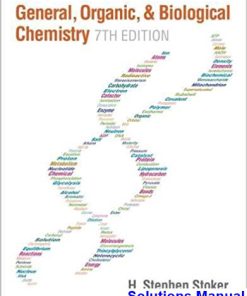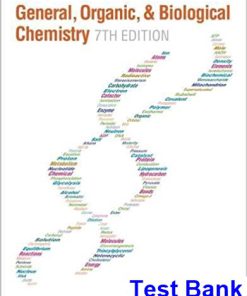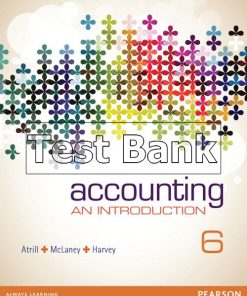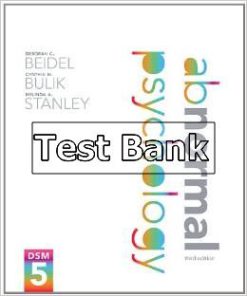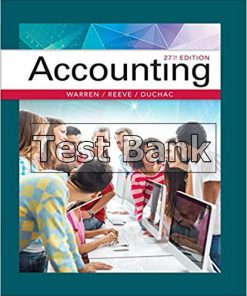General Organic and Biological Chemistry 2nd Edition Frost Test Bank
$50.00 Original price was: $50.00.$26.50Current price is: $26.50.
General Organic and Biological Chemistry 2nd Edition Frost Test Bank.
General Organic and Biological Chemistry 2nd Edition Frost Test Bank

Product details:
- ISBN-10 : 0321803035
- ISBN-13 : 978-0321803030
- Author: Laura D. Frost
Frost and Deal’s General, Organic, and Biological Chemistry gives students a focused introduction to the fundamental and relevant connections between chemistry and life. Emphasizing the development of problem-solving skills with distinct Inquiry Questions and Activities, this text empowers students to solve problems in different and applied contexts relating to health and biochemistry. Integrated coverage of biochemical applications throughout keeps students interested in the material and allow for a more efficient progression through the topics.
Concise, practical, and integrated, Frost’s streamlined approach offers students a clear path through the content. Applications throughout the narrative, the visual program, and problem-solving support in each chapter improve their retention of the concepts and skills as they master them. General, organic, and biological chemistry topics are integrated throughout each chapter to create a seamless framework that immediately relates chemistry to students’ future allied health careers and their everyday lives.
Table contents:
Chapter 1: Chemistry Basics: Matter and Measurement
1.1 Classifying Matter: Mixture or Pure Substance
1.2 Elements, Compounds, and the Periodic Table
1.3 Math Counts
1.4 Matter: The “Stuff” of Chemistry
1.5 Measuring Matter
1.6 How Matter Changes
Chapter 2: Atoms and Radioactivity
2.1 Atoms and Their Components
2.2 Atomic Number and Mass Number
2.3 Isotopes and Atomic Mass
2.4 Radioactivity and Radioisotopes
2.5 Nuclear Equations and Radioactive Decay
2.6 Radiation Units and Half-Lives
2.7 Medical Applications for Radioisotopes
Chapter 3: Compounds: Putting Particles Together
3.1 Electron Arrangements and the Octet Rule
3.2 In Search of an Octet, Part 1: Ion Formation
3.3 Ionic Compounds–Electron Give and Take
3.4 In Search of an Octet, Part 2: Covalent Bonding
3.5 The Mole: Counting Atoms and Compounds
3.6 Getting Covalent Compounds into Shape
3.7 Electronegativity and Molecular Polarity
Chapter 4: Introduction to Organic Compounds
4.1 Alkanes: The Simplest Organic Compounds
4.2 Representing the Structures of Organic Compounds
4.3 Families of Organic Compounds–Functional Groups
4.4 Nomenclature of Simple Alkanes
4.5 Isomerism in Organic Compounds
Chapter 5: Chemical Reactions
5.1 Thermodynamics
5.2 Chemical Reactions: Kinetics
5.3 Overview of Chemical Reactions
5.4 Oxidation and Reduction
5.5 Organic Reactions: Condensation and Hydrolysis
5.6 Organic Addition Reactions to Alkenes
Chapter 6: Carbohydrates: Life’s Sweet Molecules
6.1 Classes of Carbohydrates
6.2 Functional Groups in Monosaccharides
6.3 Stereochemistry in Monosaccharides
6.4 Reactions of Monosaccharides
6.5 Disaccharides
6.6 Polysaccharides
6.7 Carbohydrates and Blood
Chapter 7: What’s the Attraction? State Changes, Solubility, and Lipids
7.1 Types of Attractive Forces
7.2 Liquids and Solids: Attractive Forces are Everywhere
7.3 Attractive Forces and Solubility
7.4 Gases: Attractive Forces are Limited
7.5 Dietary Lipids and Trans Fats
7.6 Attractive Forces and the Cell Membrane
Chapter 8: Solution Chemistry: How Sweet is Your Tea?
8.1 Solutions are Mixtures
8.2 Formation of Solutions
8.3 Chemical Equations for Solution Formation
8.4 Concentrations
8.5 Dilution
8.6 Osmosis and Diffusion
8.7 Transport Across Cell Membranes
Chapter 9: Acids, Bases, and Buffers in the Body
9.1 Acids and Bases- Definitions
9.2 Strong Acids and Bases
9.3 Chemical Equilibrium
9.4 Weak Acids and Bases
9.5 pH and the pH Scale
9.6 pKa
9.7 Amino Acids: Common Biological Weak Acids
9.8 Buffers and Blood: The Bicarbonate Buffer System
Chapter 10: Proteins: Workers of the Cell
10.1 Amino Acids-A Second Look
10.2 Protein Formation
10.3 The Three-Dimensional
Structure of Proteins
10.4 Denaturation of Proteins
10.5 Protein Functions
10.6 Enzymes—Life’s Catalysts
10.7 Factors That Affect Enzyme Activity
Chapter 11: Nucleic Acids: Big Molecules with a Big Role
10.1 Components of Nucleic Acids
10.2 Nucleic Acid Formation
10.3 DNA
10.4 RNA and Protein Synthesis
11.5 Putting It Together:
The Genetic Code and
Protein Synthesis
11.6 Genetic Mutations
11.7 Viruses
11.8 Recombinant DNA Technology
Chapter 12: Food as Fuel: A Metabolic Overview
12.1 How Metabolism Works
12.2 Metabolically Relevant Nucleotides
12.3 Digestion—From Food Molecules to Hydrolysis
Products
12.4 Glycolysis—From Hydrolysis Products to Common
Metabolites
12.5 The Citric Acid Cycle—Central Processing
12.6 Electron Transport and Oxidative
Phosphorylation
12.7 ATP Production
12.8 Other Fuel Choices
People also search:
general organic and biological chemistry 2nd edition
principles of general organic and biological chemistry
an introduction to general organic and biological chemistry
an introduction to general organic and biological chemistry 13th edition
general organic & biochemistry 2nd edition by james armstrong
Instant download after Payment is complete
You may also like…
Solutions Manual
General Organic Biological Chemistry 2nd Edition Smith Test Bank
Chemistry
General Organic and Biological Chemistry 2nd Edition Janice Gorzynski Smith Solutions Manual
Related products
Test Bank




